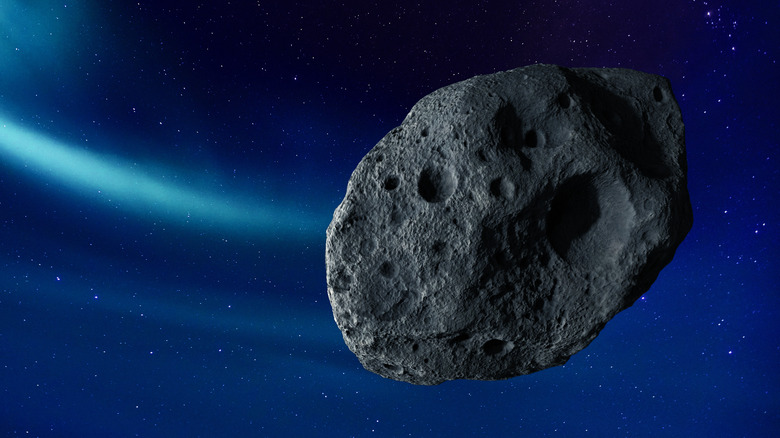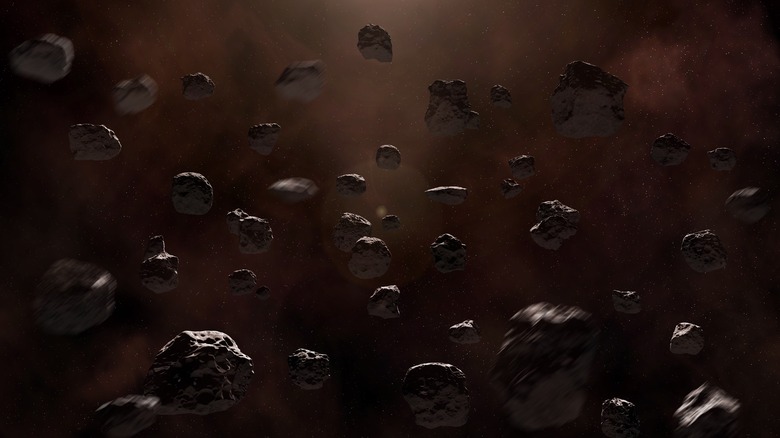NASA Rammed A Spaceship Into An Asteroid And Made A Fascinating Discovery
In the movies, if an asteroid is hurtling towards Earth, Bruce Willis or Robert Duvall just blows it up and we're all good. But what would we do if our planet really faced such a threat from space? Well, it turns out our real-life approach wouldn't be that much different. Japan has already experienced the perks of bombing an asteroid, and NASA has previously demonstrated that smashing a spacecraft into one of these flying rocks is an effective way of changing its orbit and trajectory. Unfortunately, there were unforeseen consequences to this latter demonstration, as the impact flung hundreds of boulders into orbit which didn't exactly behave the way NASA expected. So if Earth ever does find itself in the path of a potentially destructive asteroid, experts will have to think very carefully about the physics involved in deflecting it.
In 2022, NASA demonstrated its planetary defense technology, known as the Double Asteroid Redirection Test (DART), which involved smashing a spacecraft into the Dimorphos asteroid at 15,000 mph. At the time, the agency heralded the success of the mission, which showed it was possible to hit an asteroid in orbit. But NASA still had to continue observing Dimorphos to determine whether the mission had affected its orbit. Two weeks later, it was confirmed that the DART mission had successfully altered the orbit by 32 minutes, a massive difference compared to the goal of a 73-second orbit change. The impact also dramatically changed the shape of Dimorphos, all of which meant the mission was a success all around.
But a July 2025 study published in The Planetary Science Journal explains how the boulders ejected by the DART impact throw up several problems of their own when it comes to planning future impacts aimed at changing an asteroid's orbit. In other words, we'll have to be even more careful if we ever do find ourselves faced with diverting an asteroid.
There's something unknown at work in asteroid impacts
Thankfully, we haven't yet needed to deflect any asteroids that would otherwise collide with our planet (though an asteroid big enough to destroy a city did just miss Earth in 2022). Still, we obviously want to be as prepared as possible in that regard, and smashing a craft into a distant moon was one way to do that. Dimorphos is actually the moon of the asteroid 65803 Didymos, which does pass relatively close to Earth, though it doesn't pose any threat to our planet. As such, it was the ideal candidate for NASA to practice its "kinetic impactor" defense technique.
When the DART spacecraft hit Dimorphos, it was accompanied by a separate craft from the European Space Agency (ESA). This Light Italian Cubesat for Imaging of Asteroids (LICIACube) documented the aftermath of the collision, tracking the pieces that had been blasted from the surface of Dimorphos upon impact. After studying the data collected by LICIACybe, researchers led by University of Maryland astronomer Tony Farnham published their findings and revealed that they had identified clusters of boulders between 0.7 and 11.8 feet in radius which had been shot into orbit at speeds up to 52 meters per second (116 mph) after the impact. These boulders, of which there were 104 total, actually had three times more momentum than the DART spacecraft itself.
The boulders are thought to be remnants of larger rocks which were smashed into smaller pieces when the DART spacecraft collided with the asteroid's surface. Rather than being flung into random orbits and trajectories, however, these boulders are now arranged in specific patterns. Specifically, they formed two distinct clusters. In a statement published on the University of Maryland site, Farnham explained that this unexpected arrangement means that "something unknown is at work here."
Experts will have to be a lot more careful about asteroid deflections
Because the boulders ejected from Dimorphos' surface actually gave "an additional kick" that was almost as big as the impact of DART itself, the physics involved in these types of asteroid defense maneuvers become much more complicated. This "kick" provided by the boulders resulted in momentum that was perpendicular to DART's original trajectory, which could have sent Dimorphos hurtling off into space. That means future attempts to divert asteroids will have to take into account a lot more in terms of physics than previously thought. As study co-author Jessica Sunshine said in an article on the University of Maryland website, "If an asteroid was tumbling toward us, and we knew we had to move it a specific amount to prevent it from hitting Earth, then all these subtleties become very, very important."
There's also the issue of surface type, as the landscape into which you smash a spacecraft seems to matter quite significantly. As explained in the University of Maryland statement, NASA's previous Deep Impact mission involved sending an "impact probe" to collide with Comet 9P/Tempel. But in this instance, the surface was much more smooth and free of large objects than Dimorphos. As such, none of the strange results of the DART mission were observed.
Researchers will now investigate further in order to understand the results of the DART impact more thoroughly and ultimately shed more light on how best to use these impacts to deflect asteroids in future.


